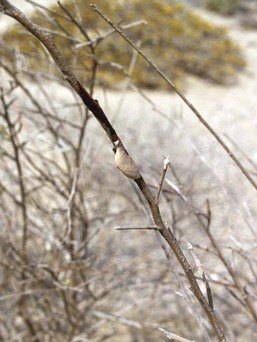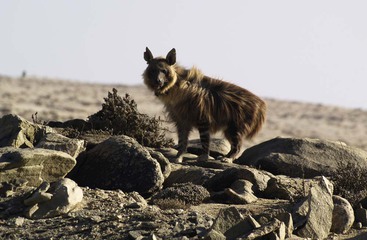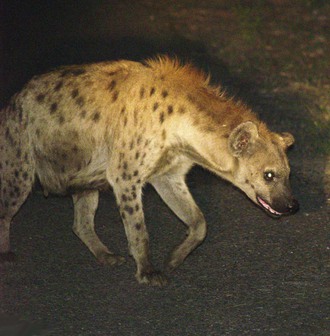William Kirk Suedmeyer The family Hyaenidae diverged from the family Viveridae 24 million years ago at the beginning of the Miocene period.5 The family comprises four species in three genera (Table 51-1). The spotted hyena is the most commonly encountered species in the wild; aardwolves, and striped hyenas, and brown hyenas are rarely encountered because of their smaller size, nocturnal habits, and solitary nature. Hyenas as a group communicate through vocalizations, body posture, and scent marking, the last of which is highly developed in the brown hyena and consists of two components, which dry to different colors and consistency on prominent vegetation (Figure 51-1). Brown hyenas are nocturnal, solitary animals that travel 25 to 40 kilometers (km) per night in search of food. They live in small clans composed of several females, males, and offspring. Clans are rather female bonded, and females are believed to be related (Wiesel, personal communication). Nomadic males are believed to maintain genetic diversity by ranging across clan territories. Males and females are morphologically similar. All clan members participate in communal raising of offspring. Although they are predominantly scavengers, brown hyenas actively hunt and consume Cape fur seal pups (Arctocephalus pusillus) along the Namibian coast.24 In more arid areas, brown hyenas also consume plant material such as Tsama (Citrullus lanatus) and gemsbok cucumbers (Acathosicyos naudinianus).15 Diamond mining, vehicular trauma, and human encroachment threaten existing populations of the brown hyena. Estimates of population size range from 5000 to 8000 in the wild and an estimated 800 to 1000 individuals in Namibia. Brown hyenas are not housed in North American zoos and are rarely exhibited in international zoos. Spotted hyenas live in large maternally dominated clans composed of multiple related individuals. Males emigrate and become nomadic, breeding across neighboring clans.3 Offspring are raised by the maternal adult. The genitalia of both sexes appear similar; the female exhibits a peniform clitoris; the vagina has fused with the urethra into a common urogenital tract and terminates in a phallic opening.12,16 Modification of the labia has developed into a false scrotum, containing organized adipose tissue. This modification of the reproductive tract is under the androgenizing effects of androstenedione.8 This modification appears to enforce maternal dominance of clan society.15 Females of this species are larger than their male counterparts. Spotted hyenas are well known to scavenge carcasses from lions but will also actively hunt prey as big as zebras.5 Spotted hyenas are not known to eat herbage. Hunting, human encroachment, and vehicular trauma contribute to declining populations across their range. Current estimates place the wild population between 27,000 and 47,000 individuals.13 The spotted hyena is occasionally exhibited in North American zoos. Aardwolves are uniquely adapted to a diet consisting nearly exclusively of harvester termites (Trinervitermes and Hodotermes sp.), These termites are nocturnal, providing ideal foraging opportunities for the aardwolf. Occasional consumption of rodents, carrion, and eggs has been documented.5 Aardwolves are solitary, nocturnal foragers and seem to be monogamous. Offspring are raised by both parents. Underground burrows are frequently used for raising cubs or providing shelter during daylight hours. Territorial boundaries are marked, as in other hyenas, through anal gland secretions placed on prominent vegetation. Scent marked areas increase in density around dens and latrines. Aardwolves prefer open dry areas with short grass, especially overgrazed farmland.5 Population estimates are not available, but aardwolves are widely distributed and are thought to be common, but rarely seen animals. No significant threats to the population seem to exist, although wire snares, hunting, and human encroachment may impact local aardwolf densities. Aardwolves are occasionally exhibited in North American zoos. Striped hyenas are the most widely distributed hyena, preferring dense, arid, mountainous scrub woodland, and thornveld.5 Striped hyenas are strictly nocturnal, mostly solitary animals but have been observed in small family groups when foraging. Adult and sub-adult animals participate in caring for offspring in communal dens. Nomadic males are believed to maintain genetic diversity by ranging across clan territories. Males and females are morphologically similar. All clan members participate in communal raising of offspring. Although these hyenas are predominantly scavengers, striped hyenas actively hunt and consume flying insects, small rodents, and birds and capture larger prey such as Cape hares (Lepus capensis) and bat-eared foxes (Otocyon megalotis).5 Like the brown hyena, striped hyenas occasionally eat fruit, specifically the desert date (Balanites sp.).5 The world population is estimated at 5000 to 10,000 individuals.7 None of the hyena species is considered endangered or threatened. Hyenas, with the exception of the aardwolf, are powerful animals; the well-developed forelimbs, shoulders, and neck provide ample power to dismember prey animals much larger in size than themselves. The relatively weak hindlimbs sustain long distance loping, which is advantageous when hunting faster, but less so when hunting prey with endurance or distance scavenging. The jaws of the brown, spotted, and striped hyenas are very powerful, able to crush most long bones of large prey items. The brown hyena is also able to break ostrich (Struthio camelus) eggs, whereas the spotted hyena cannot.1 The dental formula of the hyenas is: incisors (I) 3/3, canines (C) 1/1, premolars (P) 4/3, and molars (M) 1/1,17 whereas that of the aardwolf which is uniquely adapted to an insect diet, is: I 3/3, C1/1, P 3/2-1 and M 1/1-2.13 All hyenas have four digits on the forelimbs and hindlimbs, with the exception of the aardwolf, which has five digits on the forelimbs and four on the hindlimbs. The pelage is a mix of spots, stripes, and muted shades of brown and black; long and shaggy in the aardwolf, brown (Figure 51-2), and striped hyenas and short and sparse in the spotted hyena (Figure 51-3). Scent marking is the most important form of communication among hyenas. The anal glands are highly developed and large in each species and secrete a pheromone-laced sebaceous paste on prominent vegetation. Scent marking is used to define territories, signal potential mates, and identify conspecific and contraspecific individuals.5,17 Hyena reproduction relies on complex social structures.5,17 Specific reproductive data are provided in Table 51-2.7 Dystocia has been documented in captive spotted hyenas, all of which were surgically corrected.4 Other reproductive tract abnormalities are not reported in the literature but likely are similar to the problems in domestic dogs and cats. TABLE 51-2 Reproductive Data for Hyaenidae7 Hyenas are intelligent, destructive animals that need secure caging. The nocturnal, secretive nature of hyenas presents unique challenges for exhibit in captivity. The complex social structure of the spotted and brown hyena dictates that these animals be housed in compatible groups. All hyenas should be provided with adequate space, dens, and stimulating enrichment to prevent stereotypical behavior; they should be given opportunities to participate in training programs, which have been developed for captive spotted hyenas in a number of institutions. Captive hyenas fare well on commercial meat-based diets supplemented with nutritionally sound dog food and large bones. Aardwolves have been maintained on ground meat, milk, eggs, and supplemental vitamins7,18 but may benefit from specialized insectivore diets. All species of hyena require chemical restraint for examination. In general, remote delivery systems work well, although smaller individuals may be hand-injected through the use of a standard restraint device. The drugs of choice when immobilizing hyenas are listed in Table 51-3.4,7,10,14,15,20 Hyenas should be administered injections into the shoulders, forelimbs, or neck, whenever possible. TABLE 51-3 Immobilizing Agents for Restraining Hyenas
Hyaenidae
Bioecology
Anatomy
Reproduction
Parameter
Aardwolf
Spotted Hyena
Brown Hyena
Striped Hyena
Sexual maturity
Unknown
2–3 years
2–3 years
2–3 years
Seasonality
Unknown
Year-round
Year-round
Year-round
Gestation
90–110 days
110 days
92–100 days
88–92 days
Litter size
1–5
1–3
1–5
1–5
Weaning age
6 weeks
6 months–1 year
3–4 months
3–4 months

Husbandry
Restraint
Species
Immobilizing Agent
Dosage (mg/kg)
Reversal Agent (mg/kg, IM)
All
Tiletamine/zolazepam
5
None
All
Ketamine/xylazine
8–10/0.5–1.0
Yohimbine 0.11–125
Aardwolf
Ketamine/acepromazine
15/0.3
None
Spotted hyena
Etorphine/xylazine
0.05/0.63
Naltrexone 100 mg per 1 mg etorphine and Yohimbine 0.125
Ketamine/xylazine
13.2/6.3
Tolazoline 3.7 or yohimbine 0.125
Brown hyena
Ketamine/medetomidine*
2–3/0.035–0.045
Atipamezole 5× mg amount of medetomidine
Ketamine
15
None ![]()
Stay updated, free articles. Join our Telegram channel

Full access? Get Clinical Tree


Hyaenidae
Chapter 51




